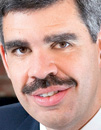The nation's 10.2% unemployment rate — the highest level in 23 years — is being viewed by some analysts not as a peak but as the beginning of a sustained period of above-average unemployment.
For money managers and financial advisers, the possibility that unemployment could soon reach 12% or 13%, followed by several years of higher unemployment, will alter asset allocation strategies and require new ways of helping clients navigate in rough seas.
“In this kind of environment, the theme is to diversify against the dollar and be defensive against U.S. equities,” said Tim Knepp, chief investment officer of Genworth Financial Asset Management Inc.
Mr. Knepp, whose firm manages $7 billion, said his diversification strategy includes allocations to Asian fixed-income and global-infrastructure investments, which are less dependent on the U.S. consumer.
Investing and allocating based on the strength of U.S. consumer spending is an example of how high unemployment can influence economic behavior, according to Mohamed El-Erian, chief executive and co-chief investment officer of Pacific Investment Management Co. LLC.
“The markets and the policymakers have underestimated how high unemployment could go and how long higher unemployment could last,” he said, suggesting that this “new normal” of sustained higher unemployment is becoming a leading indicator of how government, consumers and the financial markets react.
“A sharp rise in unemployment, coupled with the recognition that it will stay high for a while, changes the behavior of the employed, and it changes government behavior,” Mr. El-Erian added. “I guarantee you that within six months' time, there will be talk of another stimulus plan related to unemployment.”
The scenario laid out by Mr. El-Erian suggests that not only is unemployment likely to continue to climb, but it could take six years or more just to fall to the 7% range, and even that is still about 2 percentage points above historical norms.
“Unfortunately, what we're seeing today is an unemployment problem that is both structural and protracted in nature,” he said.
Mr. El-Erian cited the automobile, financial and real estate industries as examples of structural employment changes, where many thousands of jobs have been eliminated and will not be replaced.
The near-term effect is that the Federal Reserve will continue to hold down interest rates, already set at almost zero. The collateral damage of such a policy will be a continued weakening of the U.S. dollar, Mr. El-Erian said.
Longer-term, he expects U.S. consumer spending to pull back, leading to slower growth for the U.S. economy and a gradual global realignment in which the United States is no longer the dominant driver of the global economy.
Although unemployment rates are traditionally seen as a lagging economic indicator, some money managers are looking at this unique unemployment trend as a leading indicator.
“If I'm running these companies today, I would see tax increases and an uncertain regulatory and policy environment, so if businesses do start to hire, they're only going to start on the temp side of the market,” said Ann Miletti, who manages more than $2 billion for the Wells Fargo Funds Management Group.
“It's not unreasonable to think unemployment could go to 12%, and I don't disagree with the idea that longer-term unemployment could stay high,” she said. “I think we're looking at a stock picker's market where we'll be looking for companies that can grow through a tough environment.”
While economists are projecting that the U.S. economy will grow at a rate of between 3% and 3.5% next year, that level of growth equates to a reduction of only 1 or 2 percentage points in the unemployment rate.
The economy needs to grow by at least 2.5% just to keep up with monthly eligible worker growth of between 110,000 and 140,000.
“If the economy keeps growing, over the course of two years, the unemployment rate could be down to 7%, but that's nobody's definition of full employment,” said Bill Cheney, an economist with John Hancock Financial Services Inc.
The last time monthly unemployment broke the 10% mark was 1983 when the economy was charging out of a deep recession.
One substantial difference be-tween then and now is that on the way out of that economic downturn the quarterly GDP growth rates were coming in at between 7% and 9% — less than half the most optimistic estimates for the current recovery.
“We're facing a lot of special factors that are head winds to the recovery,” Mr. Cheney said. “Commercial real estate is still crumbling, state and local governments are broke, and the credit markets are still frozen, plus consumers have huge real estate losses to deal with, and that means people really are poorer.”
Meanwhile, there is the argument that some of the job cuts made over the past year were too deep, and companies will be forced to start hiring again.
“When the layoffs started, it wasn't just the fat, but muscle and bone was also cut, and now companies are squeezing as much as they can out of their employees, while corporate executives are still reluctant to hire,” said John Buckingham, chief investment officer at Al Frank Asset Management Inc.
“Historically, unemployment peaks have been a great time to invest, because companies need to do inventory restocking,” he added.
E-mail Jeff Benjamin at [email protected].







